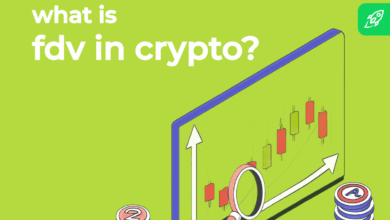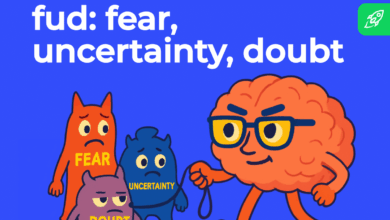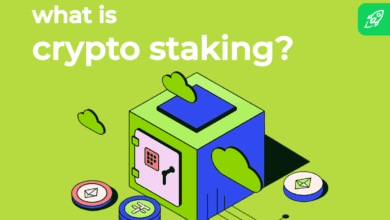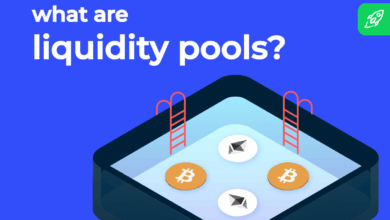What are Examples of Web3? The Future of the Internet

Even though Web3 is still in its infancy, you’ve probably heard the term come up quite frequently. It might be difficult to properly define it at the moment since it is rapidly avolving, but we’ll use this article to look at its current meaning, foundational principles and set a list of examples and explanations surrounding the concept. We’ll examine:
- what is Web3;
- how does it works;
- foundational principles;
- a list of examples; and
- possible downsides.
In an earlier blogpost, we examined the evolution of the web and the emergence of Web3. Tim Berners-Lee, the Internet pioneer, coined the term world wide web to illustrate a global web of information and resources interconnected through hypertext links. Since then, the Internet has gone a long way.
In this guide, we discuss the third generation of the world wide web, its main perks and best examples. The concept coined by Berners-Lee was often used to describe what is now known as the semantic web or a machine-to-machine Internet. The semantic web may be harder to wrap your head around than Web3 since the concept referred to a future web where computers would be able to understand Internet data directly. So while it might very well be part of the sum, up, don’t confuse Web3 with the semantic web concept since they are not necessarily synonyms.
The emergence of the Web3 concept was recognised as a way to reverse the power dynamic on the contemporary Internet and give back power to the users. Even though data protection regulations have never been so strict, the current Web2 Internet makes, more than often, users sacrifice their personal data and privacy rights in exchange for a better and customised experience.
The new Web3, or the future of the Internet, as some like to call it, is decentralised, permissionless and driven by user welfare because it aims to provide end users with full data ownership. As you can see, main features of Web3 resemble the cornerstones of blockchain technology.
Today, we are still living in a mainly Web2 era – the centralised Internet we now use. The stage following this, namely what Web3 refers to, was coined in 2014 by Gavin Wood, one of the co-founders of Ethereum. The short-named term stuck and soon became a synonym for a solution of all Web2’s problems, specifically in relation to the power stored in the hands of big tech companies.
Since 2014, Web3 became an umbrella term for anything linked to the next generation of Internet or an ecosystem of tech products that are decentralised, open source, interoperable and trustless.
If we would have to define Web3 within one sentence in a simple manner, we could say that it is an open, permissionless and decentralised network that provides a future where users and machine will be able to interact with data via peer-to-peer networks without the need of intermediaries such as authorities, centralised financial institutions and giant tech companies.
Web3 will likely be powered by blockchain technology and artificial intelligence. Such a version of the Internet wouldn’t ask users to give away their personal information in return for a better browsing experience. Similar to the process under which cryptocurrencies operate, everything would have to be verified by the network before being accepted with all information published on the blockchain’s public ledger.
From a technical point of view, Web3 can be seen as a protocol for publishing and consuming data and distributing data peer-to-peer. Secondly, we may add that it is a software package made to create tools, interfaces and digital services. Unlike Web2 that runs on centralised servers, Web3. runs on the blockchain technology and peer-to-peer networks.
Web3 will enable Internet users to use search engines and browse on the Internet much faster. In Web2 applications users interact with the front-end that communicates with their back end which then connects back with the database. As mentioned above, Web 2 is stored on central servers and transmitted through the Internet browser. In contrast to that, the new generation of Internet does not contain a central database nor a central web server. Everything will be generated with the use of blockchain technology. While Web 2 changed the commoditised personal computer technology in data centres, Web3 will push the data centres out to the edge and into the hands of ordinary users.
In Web2, we encountered for the first-time artificial intelligence and machine learning. From their introduction they had a huge impact on every software category and Web3 isn’t any different. It is based on natural language processing technologies that enable computers to understand written and spoken words. Therefore, it is set to level up the development of intuitive computer capacities, bringing it a bit closer to the semantic web vision.
The main objective of Web3 is to transform the Internet into an open network where everyone can participate, along with giving people control over their own data. The concept rests on four main attributes, as explained below.
42
The percentage of mobile apps in May 2022 containing the term “Web3” that were finance apps.
If you are a frequent reader, you probably remember that we already discussed the importance of decentralisation. Web3 won’t be governed by a central authority, central financial institution or under the control of big tech companies. It makes sure that ownership is properly distributed across all users within the network.
Web3 will make it possible for people to interact with data in conjunction with artificial intelligence and machine learning tech. Decentralised apps (Dapps) will take the place of centralised social networks. In particular, Web3 is a decentralised network that enables users to connect directly with each other.
Another main pillar of Web3 is the use of permissionless blockchains that aid in reducing limitations posed to users. Anyone can participate in the Web3 network without the need of a prior authorization. The permissionless and trustless nature of Web3 shall enhance the overall user experience by delivering more autonomy and control.
The use of blockchain, along with decentralisation, makes Web3 more secure in contrast to its predecessors. Due to the decentralisation feature, there is no central point of attack. Increased data protection and cyber security are key attributes of Web3. The user-friendly approach makes sure that companies don’t abuse their power by storing data on centralised servers where hackers or authorities could easily access data without the user’s consent.
Web3 will allow applications to work across divergent platforms and IoT devices. Technologies associated with web 3.0 will enable easy communication between different applications and platforms, amounting to a more open web.
In practice, Web3 still hasn’t become a reality for us. However, current tech developments can do some things that are associated with the concept. Keep in mind that Web3 is not restricted to just a single segment, but to organisations with specific goals for developing the technology.
Cryptocurrency, regularly associated with blockchain that is the underlying basis of Web3, is decentralised digital money that isn’t controlled by any central authority or central financial institution.
Therefore, it is a digital and encrypted medium of exchange. Cryptocurrencies provide users with all key features of the blockchain such as complete control and data encryption. The Web3’s financial side will thrive on the use of digital money and there are already some cryptocurrencies that use its technologies.
Here are some of the most popular Web3 cryptocurrencies:
One of the most popular cryptocurrencies present-day, Ethereum forms a firm basis of decentralised finance and blockchain innovations. Developers are enabled to build DeFi apps, NFTs, and blockchain gaming on its network. In fact, Ethereum is the second largest cryptocurrency next to Bitcoin and it is on the watchlist of plenty of investors. The only problem with Ethereum is that it has slow transaction speed and high gas fees.
This is one of the most popular Web3 cryptocurrencies. Solana is considered as an alternative to Ethereum due to its efficiency, speed and extended user base. From 2017 till today, Solana became a popular option for crypto investors. It provides developers with the opportunity to create decentralised applications as it represents a framework that encompasses non-fungible tokens, blockchain games and decentralised apps that should be relevant in Web3.
This coin is not as popular as Solana and Ethereum yet, but it represents a good example of the use of web technologies. Namely, it is a system that uses blockchain to connect wireless devices with IoT networks. Nodes as hotspots are used to connect such devices to a network for the purpose of data transmission that finally amounts to low energy requirements.
The Polkadot cryptocurrency is in line with Web3 aspirations. Taking into account that one of the most significant aspects of the blockchain is interoperability or in other words, the ability to operate across divergent chains, Polkadot delivers just that. It enables users to make transactions across divergent blockchains, levelling up the interoperability and scalability attributes. The system’s framework makes it possible for Web3 applications to communicate with multiple blockchains at faster speed rates.
Flux is a true Web3 cryptocurrency as it runs on an entirely decentralised network. It presents a wide array of networks that amount to a comprehensive connection of distributed computing services. In other words, Flux has the ability to power over 4000 decentralised apps.
Decentralised autonomous organisations (DAOs) came along with blockchain and Web3 aspirations. When we think of an organisation, we usually imagine something as a business or charity that is under the control of a central authority and rooted in a system of hierarchy as its key component.
The traditional aspect of organisations makes us imagine a line of command from executives and management to other levels that may be found below in such a structure. The thing with decentralised autonomous organisations is that they flatten out such systems entirely.
It represents an organisational form based on blockchain technology that is governed by a native crypto token. Anyone who is a token holder gets the ability to vote on significant matters related to the organisation. The place once held by traditional corporate structure has been taken by smart contracts to coordinate resources and efforts towards a common purpose.
With decentralised autonomous organisations there is no need to have costly administrative sections usually found within traditional types of organisations and companies. Since every single transaction is open to the public, such organisations make it almost impossible to commit fraud in virtual reality.
It is forecasted to become the main business model associated with the rise of the new Internet. As a practical example, take a look at how Ukraine DAO managed to fund the country’s defence..
Smart contracts are self-executing digital contracts that ensure that all parties see the outcome as fast as possible. The agreement is embedded directly into lines of code making transactions more transparent, irreversible and traceable.
Smart contracts are the backbone of Web3 since most interactions that occur on decentralised apps are powered by smart contracts. Smart contracts define the semantics of Web3 applications.
The main purpose of smart contracts is to enable a secure and impartial process of executing an agreement between parties. They are trustless and work without the need for human intervention. Since they are written in code, they remove particular risks linked to miscommunication and contractual interpretation. Smart contracts are used widely in all transactions regarding digital assets.
NFTs are the cornerstone of Web3 as well. Non-fungible tokens represent a form of ownership over digital or physical assets. For example, when you buy a car, you get a paper title deed that represents ownership. NFTs do the same in the world of decentralised finance.
Taking into account that Web3 is a user-centred new generation of Internet, cryptocurrencies and NFTs are the backbone of its financial system that is transparent and secure. The new generation of Internet will be based on decentralisation, community building and consensus.
These digital tokens, based on smart contracts’ technology, have already done a lot for a number of artists worldwide since they opened new revenue streams, aided in removing barriers to enter the digital market and provided transactions without the meddling of central authorities and financial institutions.
In the section about cryptocurrencies, we mentioned that many Web3 platforms provide the developers with opportunities to develop decentralised applications. We mentioned the word decentralised a lot so let’s lay down a practical example.
For example, when you use a digital service such as Google Docs, you are using a centralised cloud-based application. That means that there is some kind of trade-off. Google gets access to all the information in your documents, and you get the possibility of storing information in the cloud and enjoying a number of cloud-based benefits. You basically trade your valuable data for convenience.
Since our example is about a cloud-based service, we can point out that the role of decentralised applications will be huge in Web3 cloud storage solutions. All existing Web2 examples of cloud storage services, such as Google and AWS, are entirely centralised applications.
With centralised apps, the danger that valuable data could be distributed to third parties or modified remains. On the contrary, decentralised cloud storage services could provide encrypted and distributed data storage.
Technically, data would be divided into many fragments and users would be able to retrieve these fragments according to their personal requirements. There are already some Web3 examples, namely leading decentralised storage solutions such as Storj and Sia.
Hence, decentralised apps give you the possibility to get access to all cloud-related benefits without being under the control of a central authority. Decentralised applications use blockchains technology, for example the Ethereum blockchain, to execute their online computation. They are only submitted to Web3 requirements such as being open-source and encrypted.
In other words, Web3 applications will operate on the blockchain technology, decentralised web, namely peer-to-peer networks, or a hybrid of these two. Such decentralised apps are known as dApps.
Centralised social networks have majorly dominated in the Web 2.0 era highlighted by digital marketing and customised services. Again, users had to trade their data to get a user experience on the Internet tailored to their specific needs. As they say, data is the new oil.
The constant abuses of power by central authorities and tech companies amounted to the enactment of many data protection regulations worldwide. The emergence of Web3 refers sometimes to a radical departure from the way things have been done in the Web2 era to giving back power and data ownership to Internet users.
Decentralised social network platforms bring to the table a bunch of benefits. They safeguard the users’ privacy, empower users, remove the need for intermediaries, and take the best out of artificial intelligence and machine learning technologies.
Even though Web3 social networks are still in the early phase of development, a few of them have already emerged to the surface.
Sapien is a social news platform that is based on the Ethereum blockchain. It serves as a decent alternative to Facebook, Twitter, or even Google in the aspect of having a social news platform.
Sola is a network representing another hybrid of media and social network platforms. It is based on blockchain and artificial intelligence technology to provide a customised experience for users without the poor bargain of trading data for convenience.
Steemit is another Web3 example of social media. It can be described as a reward platform that helps users create content and monetize it accordingly. Such a social media platform that enhances user-generated content runs entirely on the Steem blockchain. It is a platform similar to Reddit.
Decentralised exchanges come along as Web3 examples as well. Their main advantages are linked to cheaper and faster transactions, security and compatibility with hardware wallets.
Users have the possibility of entirely exercising control over their funds. For example, IDEX and EOSFinex are the most popular decentralised exchange services.
IDEX is a popular and widely used online service for trading ERC-20 tokens. IDEX contains a user-friendly interface. Anyone with an Ethereum wallet can trade on its platform.
EOSFinex is a decentralised exchange that runs on the EOS software. It is currently being developed by Bitfinex.
Edge computing is something as an antithesis of big data computing in big, centralised centres since it happens literally on the networks’ edges. The term that refers to distributing computing is about delivering valuable data and services online as close to where it is being requested.
For instance, data might be processed on your computer before being sent along to another location. Thereby, you can mix the processing power of IoT devices on the networks’ edges into one big, decentralised computer.
Web3 and its many examples are still in the early phase of development. Even though technologies such as blockchain, artificial intelligence, and machine learning make it possible for many of Web3 perks to function, we won’t be anytime soon to experience the full Web3 experience.
The concept of Web3 certainly is the future web in terms of user-friendliness, data ownership, security, and transparency. There are some current drawbacks we hope will be dealt with in the future.
For example, less advanced devices will not be able to handle Web3 requirements and other implementation challenges. On the other hand, the concept may be hard for newcomers to understand so it may take some time to spread the word and educate people.





